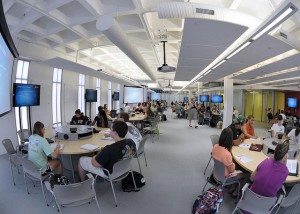Feb
2016
Innovation in the ClassRoom
Summary of “Pedagogy Matters, Too: The Impact of Adapting Teaching Approaches to Formal Learning Environments on Student Learning” – D. Christopher Brooks, Catherine A. Solheim
In this article, D. Brooks and Catherine Solheim examines the how students learn and receive information when taught in an active learning environment. The study began in the fall 2009 on the campus of the university of Minnesota. The experimenters wanted to produce constant data over multiple semesters. So the study was conducted using the same instructor, classroom (student in the ALC), and personal finance course.
Once Brook and Solheim, created the constant they started the active learning experiment, also known as the qusi-experiment. The course –Personal Family Finance converted from a traditional lecture into an active learning environment. In the team learning environment, the students had mandatory class attendance, viewed videos, and other required material before each class. (Brown 54) Also the traditional use of hardback textbooks were nixed from the active classroom setting and now student receive crucial information through technological mediums.
After the active learning approach had been implemented to the personal Finance course, brown and Solheim collected data from one-hundred and eleven students who had been expose to the active learning course in the fall of 2009. The Students were asked at the end of the semester to complete a forty-five question survey on their experience in the active learning environment. Once the data was collected, brown and solhiem observed that the student who took the traditional Personal Finance course in the fall of 2008 received an overall grade of 81.80 and the students who were exposed to the qusi-experiment in the fall of 2009 received an overall grade of 85.50. (Brown 56) These results reinforced the experimenter’s original hypothesis that the active learning approach would increase the grade average of student who were actively engaged in the learning process then those who are not.
In addition to the initial results displayed about the increase in grade point average in students in the active learning course, another explanation is the difference in presentation the course assignments. This is due to the fall 2009 ALC students having been introduce to the assigments in an engaged manner than the traditional learning students. The data collected that students that received engaged approach to major course assignments produced high averages. ALC students received 14.60 percent higher on participation, 5.36 percent on the financial planner, 6.43 percent on case studies, 13.60 percent on the final exam, and 9.31 on various quizzes. (Brown 58)
Fortunately, the final condenses of the qusi-experiment conducted by Brown and Solhiem rendered three conclusions. The first is that the ALC learning approach should be considered in colleges and universities. Secondly, instructors teaching the course should approach the course which an active learning mentality. And the third conclusion is that there is more than ALC method of teaching, and each instructor must find the style and method that is most effective for them as in individual.
As time continues and technology becomes more prevalent in our everyday society active learning approach will be implemented more over time.
